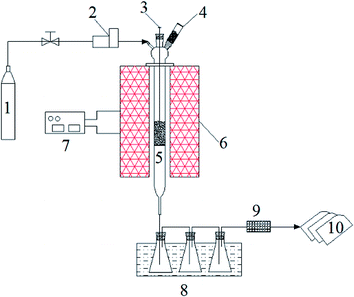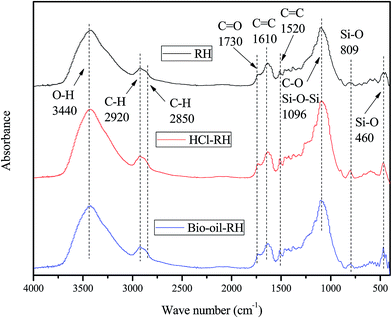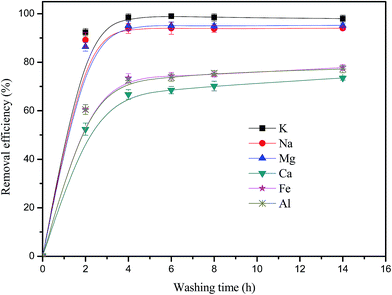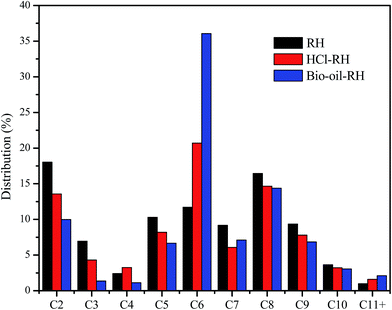Washing pretreatment with light bio-oil and its effect on pyrolysis products of bio-oil and biochar
Shuping Zhang and
Yuanquan Xiong*
Key Laboratory of Energy Thermal Conversion and Control of Ministry of Education, School of Energy and Environment, Southeast University, Nanjing 210096, China. E-mail: yqxiong@seu.edu.cn; Fax: +86 25 83795053 8004; Tel: +86 25 83795053 8001
First published on 23rd December 2015
Abstract
Rice husk is an abundant agricultural waste and the method commonly used for the disposal of rice husk could cause serious environmental and human health problems. Herein, an attempt is made to convert rice husk into value added bio-based products, such as bio-oil and biochar, using washing pretreatment with light bio-oil followed by fast pyrolysis. It can be found that the washing pretreatment with light bio-oil effectively removes a large amount of alkali and alkaline earth metals (AAEMs), and has higher removal efficiency than aqueous HCl at the same pH of 2.8 because the phenolic compounds in light bio-oil promote the removal of some AAEMs. Furthermore, the pyrolysis of washed rice husk with light bio-oil results in an increase in bio-oil yield and decrease in water and biochar yields. GC/MS analysis indicated that light bio-oil washing pretreatment prior to a fast pyrolysis process has an important effect on the quality of bio-oil, which results in a significant increase in the relative content of levoglucosan in bio-oil along with a reduction of low molecular weight compounds. Biochar, which is produced in higher yield, has a high silica content and high surface area, and has the potential to produce amorphous silica as well as adsorbent or catalyst support. This study reveals a promising process to convert biomass waste into quality bio-based products.
1. Introduction
Biomass has received considerable attention because of its renewability, carbon neutrality and low emission of pollutants. Therefore, biomass plays a significant role as an alternative source for energy and fuel production around the world. According to recent estimations, the global production of rice is approximately 685 million tons, with the production of rice husk per kg harvested being between 0.2 and 0.33.1 Rice husk is usually handled as waste and burnt in open fields, and this practice results in serious environmental and human health problems due to the formation of fine crystalline silica particles. Therefore, the use of rice husk for energy not only reduces pollution, but also generates economic benefits.Fast pyrolysis is considered as one of the most promising technologies for the thermo-chemical conversion of rice husk to bio-based products such as biochar, bio-oil and syngas. It has been reported that several factors may influence the pyrolysis behavior of rice husk such as the conversion units, operating conditions and chemical composition of the species.2,3 Several studies have suggested that the properties of pyrolysis products significantly dependent on the amounts of its primary components (cellulose, hemicellulose and lignin) and inorganic species.4,5 Moreover, it has been reported that the existence of some interactions between the main biomass components affect the pyrolysis behavior.6 The large amount of inorganic species remaining in biomass still pose a challenge, especially for agriculture residues that usually contain high contents of alkali and alkaline earth metals (AAEMs).7 On the one hand, it is well-known that AAEMs in biomass have significant impact on pyrolytic pathways, such as they decrease the bio-oil yield and increase the biochar yield. Furthermore, AAEMs can promote the formation of more water and organic acids, and thus lower the bio-oil quality.8,9 On the other hand, K and Na, along with S and Cl, are known to cause environmental and technological problems during combustion and gasification, such as slagging, fouling and high temperature corrosion.10 Thus, the removal of metallic species, in particular, AAEMs, prior to pyrolysis is an important pretreatment method for rice husk.
It has been known that water washing is a simple and effective pretreatment method to remove a large amount of troublesome elements (K, Cl and S) from biomass.7,11 However, water-soluble metallic species account for no more than 30–80% of the total because of the presence of organically bound species in the form of carboxylates and inorganic minerals.12 In addition, acidic media, such as mineral or organic acids, have been reported to have higher efficiency for the removal of AAEMs.13 However, the use of a mineral acid is not reasonable in practice, because they can introduce undesirable P, Cl, S, and N elements into the pretreated biomass, contaminating the final products. Moreover, using organic acids (i.e. acetic acid) for washing biomass is not necessarily feasible from an economical point of view. Bio-oil produced from the pyrolysis of biomass is often a homogeneous mixture of water and organic matter rich in acetic acid and non-acids.14 In addition, high water content in bio-oil can easily lead to phase separation into an aqueous and an organic phase. Thus, light bio-oil (namely, aqueous phase) has the potential as an agent for leaching AAEMs. Oudenhoven et al.15 recently proposed an application to utilize the organic acids produced in the pyrolysis process itself to reduce the AAEMs content in woody biomass, which results in the increase in bio-oil and levoglucosan yields after pyrolysis. In addition, the leaching of AAEMs from rice husk with bio-oil from the pyrolysis of the same rice husk has also been reported.16 These previous studies achieved remarkable advances in understanding the washing of biomass with bio-oil obtained from its own pyrolysis. However, the effects of washing with light bio-oil on the yield and quality of pyrolysis products of rice husk have not been fully investigated.
In this study, rice husk is used as a raw material to investigate the effect of the washing pretreatment with light bio-oil on the fuel properties and the removal efficiency of metallic species in biomass. Subsequently, fast pyrolysis experiments of the washed rice husk were performed using a fixed-bed pyrolysis reactor. The yield and quality of bio-oil and biochar products are analyzed to provide data for biomass pyrolysis and for further utilization of biomass resources.
2. Materials and methods
2.1. Materials
The biomass feedstock of rice husk was collected from Yangzhou city, Jiangsu Province, China. Prior to the experiments, the rice husk samples used in this study were ground in a knife-mill and sieved to obtain a particle size fraction of 1–2 mm, then dried further at 105 °C for 12 h. The dried rice husk is denoted as RH.2.2. Washing experiment
The light bio-oil used in this study was obtained from the pyrolysis of rice husk at 550 °C in a microwave pyrolysis reactor. Detailed descriptions of the microwave pyrolysis system can be found elsewhere.17,18 The aqueous phase (namely, light bio-oil) was selected because it exhibits a good flowability and has a pH of 2.8. The water content of the light bio-oil was determined by Karl Fischer titration and its chemical composition was analyzed via gas chromatography/mass spectrometry (GC/MS, Agilent 7890A/5975C). It was found that the light bio-oil was a homogeneous mixture of water and organic matter. The moisture content of the light bio-oil is 60.5%. It can be seen from Table 1 that acetic acid is the most abundant and representative acid in light bio-oil, and some phenols in light bio-oil can be detected by GC/MS. For comparison, an aqueous solution of HCl (pH 2.8) was also used for washing RH in this study.| Compounds | Molecular formula | Relative content (%) |
|---|---|---|
| Acids | ||
| Acetic acid | C2H4O2 | 30.061 |
| Propionic acid | C3H6O2 | 0.524 |
| Total | 30.585 | |
![[thin space (1/6-em)]](https://www.rsc.org/images/entities/char_2009.gif) |
||
| Ketones | ||
| 2-Propanone, 1-hydroxy- | C3H6O2 | 9.139 |
| 1-Hydroxy-2-butanone | C4H8O2 | 1.647 |
| 2-Propanone, 1-(acetyloxy)- | C5H8O3 | 1.786 |
| 1,2-Cyclopentanedione | C5H6O2 | 2.471 |
| 1,2-Cyclopentanedione, 3-methyl- | C6H8O2 | 2.745 |
| Total | 17.788 | |
![[thin space (1/6-em)]](https://www.rsc.org/images/entities/char_2009.gif) |
||
| Aldehydes | ||
| Butanedial | C4H6O2 | 0.163 |
| Total | 0.163 | |
![[thin space (1/6-em)]](https://www.rsc.org/images/entities/char_2009.gif) |
||
| Furans | ||
| Furfural | C5H4O2 | 3.667 |
| 2-Furanmethanol | C5H6O2 | 2.997 |
| 2(5H)-Furanone | C4H4O2 | 1.561 |
| 2-Furancarboxaldehyde, 5-methyl- | C6H6O2 | 0.241 |
| Benzofuran, 2,3-dihydro- | C8H8O | 2.185 |
| Total | 10.651 | |
![[thin space (1/6-em)]](https://www.rsc.org/images/entities/char_2009.gif) |
||
| Phenols | ||
| Phenol | C6H6O | 2.502 |
| Phenol, 2-methyl- | C7H8O | 0.637 |
| Phenol, 4-methyl- | C7H8O | 3.321 |
| Phenol, 2-methoxy- | C7H8O2 | 4.132 |
| Phenol, 2-methoxy-4-methyl- | C8H10O2 | 1.66 |
| 1,2-Benzenediol | C6H6O2 | 2.834 |
| 1,2-Benzenediol, 3-methyl- | C7H8O2 | 1.614 |
| Phenol, 4-ethyl-2-methoxy- | C9H12O2 | 0.906 |
| 2-Methoxy-4-vinylphenol | C9H10O2 | 0.812 |
| Phenol, 2,6-dimethoxy- | C8H10O3 | 1.273 |
| Phenol, 2-methoxy-4-(1-propenyl)- | C10H12O2 | 0.461 |
| Total | 20.152 | |
The washing experiment was performed by leaching 15 g RH in 150 mL light bio-oil at 30 °C with stirring for 4 h. After washing, the sample was filtered and then rinsed with deionized water until the pH of the effluent solution was neutral. Subsequently, the wet sample was dried at 105 °C for 12 h to a constant weight. In addition, the contents of inorganic species contained in the samples before and after the washing were determined using ICP-OES (Leeman Labs Inc., USA).17 The tests were repeated three times under the same conditions to confirm reproducibility. The removal efficiency (Xi) of metallic species by washing is defined as follows:
 | (1) |
2.3. Fast pyrolysis experiment
Fast pyrolysis experiments were conducted in a fixed-bed reactor system, as shown in Fig. 1, which consists of ten components: a nitrogen cylinder, mass flow controller, thermocouple, sample feeder, quartz reactor, electric furnace, temperature controller, condensing unit, moisture trap and gas sampling bag. The quartz fixed-bed reactor (450 mm in length and 38 mm in inner diameter) was placed inside a 3 kW electrical furnace, which was controlled by a temperature controller to maintain the preset temperature. In this study, a K-type thermocouple with the diameter of 3 mm was placed at the center of the biomass-packed bed to detect the temperature to provide a reference for the temperature controller. The condensing unit, which consists of three condensate collectors and an ice-water bath, was used to collect the liquid product. The non-condensable gas was collected in 10 L Tedlar® gas sampling bags.For each experiment, to maintain an inert atmosphere, nitrogen at a flow rate of 200 mL min−1 was passed through the reactor for 15 min prior to the commencement of the experiment. When the temperature was reached and stabilized to the pyrolysis temperature (550 °C), the original and washed rice husk samples (5 g), which were placed in the sample feeder in advance, were fed into the quartz fixed-bed reactor. Then, the rice husk samples were rapidly heated to the pyrolysis temperature, followed by holding the temperature for 10 min. Biochar and bio-oil yields were calculated from the direct weight of each fraction after the reaction was completed, while gas yield was calculated by the difference based on the mass balance. All the experiments were carried out in triplicate to confirm the values obtained, and the average value is reported.
2.4. Analysis methods
The proximate analysis (ash, volatile matter and fixed carbon) of samples was carried out based on the GB/T 28731-2012 standard of China. The ultimate analysis was carried out using a Vario EL-III elementar analyser (ELEMENTAR Analysensysteme GmbH). The higher heating value (HHV) was analyzed using a SDACM3000 calorimeter. In addition, the absolute content of inorganic species contained in the original and washed rice husk samples was determined using ICP-OES (Leeman Labs Inc., USA). Each analysis was repeated three times to ensure the accuracy of the results.The chemical composition analysis of liquid products was carried out using gas chromatography/mass spectrometry (GC/MS, Agilent 7890A/5975C) with a Varian Cp-sil 8 cb capillary column (30 m × 0.25 mm i.d. and 0.25 μm film thickness). The carrier gas (helium, 99.999%) was set at a constant flow rate of 3 mL min−1. The temperature of the oven was programmed from 40 to 180 °C at the heating rate of 5 °C min−1, and then to 280 °C at the heating rate of 20 °C min−1. MS was conducted in the following operational conditions: temperature of transfer line = 230 °C and ion source = 230 °C and electron energy = 70 eV.
The physicochemical properties of biochar, such as proximate analysis, ultimate analysis and higher heating values, were also investigated, and the potential utilization value of biochar was analyzed. In this study, the pore structure properties of the biochar were studied via nitrogen adsorption isotherms at 77 K using a Micromeritics instrument ASAP 2020. The specific surface area was analyzed using the Brunauer–Emmett–Teller (BET) model. In addition, chemical compositions of the ashes obtained from the biochar were determined using XRF analysis (ARL-9800).
3. Results and discussion
3.1. Washing pretreatment with light bio-oil
| Samples | Proximate analysis (wt%, db) | Ultimate analysis (wt%, db) | HHV (MJ kg−1) | |||||
|---|---|---|---|---|---|---|---|---|
| Ad | Vd | FCd | C | H | O | N | ||
| RH | 16.53 | 70.60 | 12.87 | 38.23 | 5.467 | 39.446 | 0.327 | 16.58 |
| HCl–RH | 15.27 | 71.88 | 12.85 | 39.41 | 5.354 | 39.608 | 0.358 | 17.13 |
| Bio-oil–RH | 15.17 | 71.75 | 13.08 | 41.04 | 5.319 | 38.148 | 0.323 | 17.20 |
Previous studies have indicated that besides the inorganic components, some organic components could be leached out during the process of acid washing, which occurs when strong acids or higher temperatures (hydrolysis conditions) are applied.15 However, in this study, the washing pretreatment performed at 30 °C for 4 h indicated that no significant amount of organic components were lost during the washing. The results obtained from the FTIR spectroscopy of the original and washed rice husk samples, as shown in Fig. 2, also confirmed this. A broad band located at around 3440 cm−1 in the spectra was attributed to the stretching vibration of the O–H bonds.19 The narrow band at 2800–3000 cm−1 was assigned to the C–H stretching vibration present in alkyl groups such as methyl and methylene groups.19 The band at around 1730 cm−1 corresponding to the C![[double bond, length as m-dash]](https://www.rsc.org/images/entities/char_e001.gif) O stretching vibration was mainly caused by the free carbonyl groups, which is a typical hemicellulose marker.20 The band located at 1610 cm−1 indicated the presence of C
O stretching vibration was mainly caused by the free carbonyl groups, which is a typical hemicellulose marker.20 The band located at 1610 cm−1 indicated the presence of C![[double bond, length as m-dash]](https://www.rsc.org/images/entities/char_e001.gif) C bonds of aromatic compounds. The peaks at around 1200–1500 cm−1 were assigned to C–H and C–H2 stretching vibrations. The broad band observed at around 1096 cm−1 may be attributed to C–O and Si–O–Si stretching, which are reasonably distinctive for RH, HCl–RH and Bio-oil–RH.21 The two significant bands at 809 and 460 cm−1 indicate the presence of Si–O bonds in the original and washed rice husk samples.21 It can be observed that the original and washed rice husk samples exhibited identical spectra, confirming that there was indeed no significant loss of organic components during washing. This is because the organic contents were not decomposed under the mild washing conditions.
C bonds of aromatic compounds. The peaks at around 1200–1500 cm−1 were assigned to C–H and C–H2 stretching vibrations. The broad band observed at around 1096 cm−1 may be attributed to C–O and Si–O–Si stretching, which are reasonably distinctive for RH, HCl–RH and Bio-oil–RH.21 The two significant bands at 809 and 460 cm−1 indicate the presence of Si–O bonds in the original and washed rice husk samples.21 It can be observed that the original and washed rice husk samples exhibited identical spectra, confirming that there was indeed no significant loss of organic components during washing. This is because the organic contents were not decomposed under the mild washing conditions.
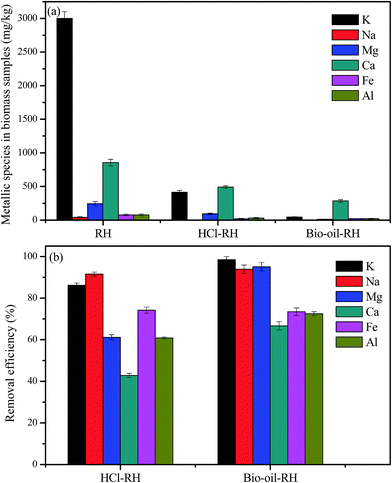 | ||
| Fig. 4 (a) The relative content of metallic species of original and washed rice husk samples and (b) the removal efficiency of metallic species due to washing pretreatment. | ||
Therefore, compared to mineral acid, light bio-oil not only has a higher removal efficiency of metallic species in biomass, but also avoids the introduction of undesirable P, Cl, S, and N into the treated biomass, contaminating the final products. Employment of an organic acid (i.e. acetic acid) for washing biomass is not necessarily feasible from an economical point of view. Furthermore, the used light bio-oil can be used to produce syngas by co-gasification with some carbonaceous material such as petroleum coke or coal.22,23 The AAEMs contained in light bio-oil play catalytic roles in the process of gasification.24
3.2. Pyrolysis performance of original and washed rice husk samples
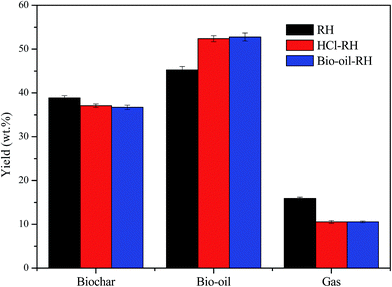 | ||
| Fig. 5 The product yields obtained from the fast pyrolysis of original and washed rice husk samples. | ||
These results can be attributed to the catalytic effect of metallic species on the pyrolysis process. As mentioned above, washing pretreatment with light bio-oil removed a large amount of metallic species, especially AAEMs. It was found that K, Na, Ca and Mg increased the gas yield, and decreased both the yield and molecular weight of the bio-oil. In addition, these metals (K, Na, Ca and Mg) behaved differently with regard to their catalytic effects on pyrolysis by concentration: K > Na > Ca > Mg.26 Washing with light bio-oil had a higher removal efficiency of K, Na, Ca and Mg than washing with aqueous HCl, thus resulting in a larger bio-oil yield compared to the rice husk washed with aqueous HCl.
The GC/MS technique was utilized to analyze the chemical components of bio-oil, and the identified compounds are listed in Table 3. It is known that the GC/MS technique cannot give quantitative analysis of bio-oil products; however, the chromatographic peak area% is linear with its content.13 The bio-oil obtained was a complex mixture that contained a wide variety of oxygenated organic compounds, and the compositions of bio-oil can be divided into seven main groups according to their functional groups, namely, acids, ketones, aldehydes, furans, phenols, sugars, and others. The relative contents of the different groups of bio-oil from the fast pyrolysis of the original and washed rice husk samples are presented in Fig. 6. In comparison to the original rice husk, the light bio-oil washed rice husk exhibited a decreased content of acids, ketones, furans and phenols. Moreover, the content of sugars, which are mainly derived from cellulose pyrolysis, was significantly increased for the light bio-oil washed rice husk samples, especially levoglucosan. It can be seen that the removal of AAEMs with the washing pretreatment affects the depolymerisation of cellulose, hemicellulose and lignin.
| Molecular formula | Compound assignment | Area% | ||
|---|---|---|---|---|
| RH | HCl–RH | Bio-oil–RH | ||
| C2H4O2 | Acetic acid | 14.732 | 9.606 | 7.340 |
| C2H8OSi | Silanol, dimethyl- | 0.369 | 0.465 | 0.595 |
| C3H6O2 | Acetol (2-propanone, 1-hydroxy-) | 6.943 | 4.294 | 1.359 |
| C6H14O2 | Ethane, 1,1-diethoxy- | 0.993 | 0.961 | 0.694 |
| C4H8O2 | 1-Hydroxy-2-butanone | 0.807 | 0.408 | ND |
| C4H6O2 | Butanedial | 1.059 | 1.748 | 0.626 |
| C5H4O2 | Furfural | 3.567 | 3.4 | 5.088 |
| C5H6O2 | 2-Furanmethanol | 2.005 | 1.214 | 0.377 |
| C5H8O3 | 2-Propanone, 1-(acetyloxy)- | 1.271 | 0.868 | 0.422 |
| C4H4O2 | 2(5H)-Furanone | 0.543 | 1.089 | 0.491 |
| C5H6O2 | 1,2-Cyclopentanedione | 3.454 | 2.71 | 0.766 |
| C6H6O | Phenol | 1.685 | 0.825 | 0.835 |
| C6H6O3 | Levoglucosenone | 0.596 | 1.748 | 4.214 |
| C8H16O3 | Furan, 2,5-diethoxytetrahydro- | 1.726 | 1.756 | 0.723 |
| C6H8O2 | 2-Cyclopenten-1-one, 2-hydroxy-3-methyl- | 2.797 | 1.548 | 1.135 |
| C7H8O | Phenol, 2-methyl- | 0.791 | 0.467 | 0.454 |
| C7H8O | Phenol, 4-methyl- | 2.215 | 1.812 | 3.103 |
| C7H8O2 | Phenol, 2-methoxy- | 5.293 | 2.978 | 2.646 |
| C9H18O3 | 2-Pentanone, 5,5-diethoxy- | 0.7 | 1.033 | 0.858 |
| C8H10O | Phenol, 4-ethyl- | 1.758 | 1.166 | 1.25 |
| C8H10O2 | Phenol, 2-methoxy-4-methyl- | 3.57 | 4.239 | 6.011 |
| C6H6O2 | 1,2-Benzenediol | 2.104 | 1.233 | 0.753 |
| C8H8O | Benzofuran, 2,3-dihydro- | 7.161 | 6.009 | 4.989 |
| C7H8O2 | 1,2-Benzenediol, 4-methyl- | 0.886 | 0.806 | 0.899 |
| C9H12O2 | Phenol, 4-ethyl-2-methoxy- | 2.406 | 1.671 | 1.613 |
| C9H10O2 | 2-Methoxy-4-vinylphenol | 5.646 | 4.425 | 3.586 |
| C8H10O3 | Phenol, 2,6-dimethoxy- | 1.35 | 0.788 | 0.763 |
| C10H12O2 | Eugenol | 0.558 | 0.508 | 0.346 |
| C8H8O3 | Vanillin | 0.887 | 0.704 | 0.628 |
| C9H12O3 | Phenol, 4-methoxy-3-(methoxymethyl)- | 0.605 | 0.665 | 0.789 |
| C10H12O2 | Isoeugenol | 2.945 | 2.388 | 2.202 |
| C10H14O2 | Phenol, 2-methoxy-4-propyl- | 0.128 | 0.312 | 0.516 |
| C6H10O5 | Levoglucosan | 3.543 | 14.391 | 28.428 |
| C11H14O3 | Phenol, 2,6-dimethoxy-4-(2-propenyl)- | 0.6 | 1.068 | 1.464 |
| C16H16O4 | 10,11-Dihydro-10-hydroxy-2,3-dimethoxydibenz(b,f)oxepin | 0.383 | 0.528 | 0.626 |
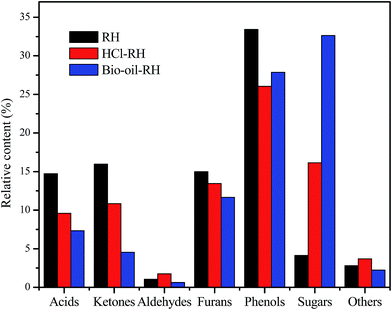 | ||
| Fig. 6 Relative contents of different groups in bio-oil from the fast pyrolysis of original and washed rice husk samples. | ||
It can be seen from Table 3 that the relative content of levoglucosan was about 3.5% from the pyrolysis of original rice husk. This value obtained from the fast pyrolysis of light bio-oil washed rice husk is almost 9 times (28.4%) of that from the fast pyrolysis of original rice husk. Levoglucosan is an important and highly valuable chemical, which can be used for polymer chemistry, pharmaceuticals, fermentation, and food applications.15 It has been reported that the presence of relatively low concentrations of AAEMs already reduces the levoglucosan yield to a large extent. It can be explained by two aspects. First, alkali metals (i.e. K and Na) actually promote catalytic reactions such as ring fission and fragmentation of a glucose unit, resulting in a lower yield of sugars and higher yield of low molecular weight compounds during fast pyrolysis. Second, alkaline earth metals (i.e. Mg and Ca) that are bound in the form of carboxylates have the effect of joining two parts of biomass structures together to act as crosslinks.9 Furthermore, the ion-exchanging process during the process of washing with light bio-oil results in the disintegration of these crosslinks in the biomass structure, which increases the yield of sugars and decreases the chance of reactions to form water.28
Fig. 7 shows the distribution of compounds with different carbon atom numbers (e.g., C4 represents all the compounds whose molecules contain four carbon atoms). The C2–C5 compounds are mainly regarded as low molecular weight compounds such as acids and ketones. The C6 compounds mainly consist of levoglucosan and levoglucosenone. The C7–C10 compounds are regarded as completely chain broken decomposed products of lignin in biomass. The C11+ compounds, which are the incompletely chain-broken decomposed products of lignin, account for only a small proportion in the bio-oils. The results obtained from Fig. 7 reveal that the presence of AAEMs in the rice husk samples effectively promotes the chain-breaking decomposition of lignin to produce much lighter compounds derived from lignin and decreases the heavier lignin derivatives. The removal of these AAEMs by washing pretreatment with light bio-oil would have decreased the crosslinking density of lignin structures to facilitate the release of large lignin fragments as lignin-originated larger oligomers in the bio-oil.29 It has been reported that the AAEMs can act as crosslinks to stabilise the 3-D structure of lignin or links between lignin and cellulose/hemicelluloses, which cause further breakdown of weak bonds to produce lighter components in bio-oil.9
| Samples | Proximate analysis (wt%, db) | Ultimate analysis (wt%, db) | HHV (MJ kg−1) | SBET (m2 g−1) | |||||
|---|---|---|---|---|---|---|---|---|---|
| Ad | Vd | FCd | C | H | O | N | |||
| RHC | 45.05 | 14.17 | 40.78 | 44.73 | 1.80 | 7.69 | 0.73 | 17.68 | 117.0 |
| HCl–RHC | 42.00 | 15.19 | 42.81 | 46.44 | 1.81 | 6.92 | 0.83 | 18.32 | 177.8 |
| Bio-oil–RHC | 41.27 | 14.30 | 44.43 | 47.89 | 1.85 | 6.13 | 0.76 | 18.85 | 198.3 |
| Constituent | RHC (wt%) | HCl–RHC (wt%) | Bio-oil–RHC (wt%) |
|---|---|---|---|
| SiO2 | 91.98 | 98.21 | 99.33 |
| K2O | 3.44 | 0.57 | 0.030 |
| CaO | 0.90 | 0.56 | 0.30 |
| SO3 | 0.52 | 0.093 | 0.096 |
| P2O5 | 0.45 | 0.098 | 0.12 |
| MgO | 0.32 | 0.16 | 0.004 |
| Fe2O3 | 0.21 | 0.064 | 0.041 |
| MnO | 0.21 | 0.16 | 0.028 |
| Al2O3 | 0.076 | 0.043 | 0.030 |
| Cl | 0.046 | 0.008 | 0 |
| Cr2O3 | 0.020 | 0.009 | 0.006 |
| Na2O | 0.067 | 0.005 | 0.005 |
| ZnO | 0.009 | 0.010 | 0.004 |
| CuO | 0.003 | 0 | 0.002 |
| TiO2 | 0.002 | 0 | 0 |
| NiO | 0.001 | 0.005 | 0.001 |
| Others | 1.75 | 0.010 | 0.001 |
The porous texture parameter is one of the crucial properties for biochar. It can be observed from Table 4 that the washing pretreatment with light bio-oil had a certain positive effect on the pore structure of biochar. The BET surface area of the light bio-oil washed rice husk biochar is 198.3 m2 g−1, and that of the HCl washed rice husk biochar is 177.8 m2 g−1, whereas that of the original rice husk biochar is only 117.0 m2 g−1. It can be seen that the biochar obtained from the fast pyrolysis of light bio-oil washed rice husk has the largest specific surface area. The results may be ascribed to the fact that the washing pretreatment with light bio-oil removes a large amount of impurities and metallic species in rice husk, which is beneficial to the development of a porous structure in biochar.33 This could improve the performance of biochar for use as an adsorbent or catalyst support.34
4. Conclusions
The results obtained in this study indicate that washing pretreatment with light bio-oil effectively removes a large amount of AAEMs, and it has a higher removal efficiency than aqueous HCl at the same pH. Furthermore, it can be found that the pyrolysis of washed rice husk with light bio-oil results in an increased bio-oil yield and a decreased biochar and water yields. Light bio-oil washing pretreatment prior to pyrolysis process has an important effect on the quality of bio-oil, which results in a significant increase in the relative content of levoglucosan in bio-oil along with a reduction of low molecular weight compounds. Washing pretreatment with light bio-oil increases the purity of silica in biochar and the specific surface area of biochar, and therefore it has the potential to be a raw material for amorphous silica, as well as an adsorbent or a catalyst support.Acknowledgements
Financial supports from the National Science Foundation of China (No. 51376047) and the National High-Tech R&D Program of China (863 Program) (No. 2011AA05A201) are sincerely acknowledged.References
- J. S. Lim, Z. A. Manan, S. R. W. Alwi and H. Hashim, Renewable Sustainable Energy Rev., 2012, 16, 3084–3094 CrossRef CAS.
- S. Meesuk, J. P. Cao, K. Sato, Y. Ogawa and T. Takarada, Energy Fuels, 2011, 25, 4113–4121 CrossRef CAS.
- Y. Y. Qian, J. Zhang and J. Wang, Bioresour. Technol., 2014, 174, 95–102 CrossRef CAS PubMed.
- D. Lv, M. Xu, X. Liu, Z. Zhan, Z. Li and H. Yao, Fuel Process. Technol., 2010, 91, 903–909 CrossRef CAS.
- J. M. Reckamp, R. A. Garrido and J. A. Satrio, Biomass Bioenergy, 2014, 71, 235–244 CrossRef CAS.
- T. J. Hilbers, Z. Wang, B. Pecha, R. J. M. Westerhof, S. R. A. Kersten, M. R. Pelaez-Samaniego and M. Garcia-Perez, J. Anal. Appl. Pyrolysis, 2015, 114, 197–207 CrossRef CAS.
- L. Deng, T. Zhang and D. Che, Fuel Process. Technol., 2013, 106, 712–720 CrossRef CAS.
- R. Fahmi, A. V. Bridgwater, I. Donnison, N. Yates and J. M. Jones, Fuel, 2008, 87, 1230–1240 CrossRef CAS.
- D. Mourant, Z. Wang, M. He, X. S. Wang, M. Garcia-Perez, K. Ling and C.-Z. Li, Fuel, 2011, 90, 2915–2922 CrossRef CAS.
- D. Vamvuka, N. Salpigidou, E. Kastanaki and S. Sfakiotakis, Fuel, 2009, 88, 637–643 CrossRef CAS.
- S. B. Liaw and H. Wu, Ind. Eng. Chem. Res., 2013, 52, 4280–4289 CrossRef CAS.
- A. Pettersson, M. Zevenhoven, B. M. Steenari and L. E. Amand, Fuel, 2008, 87, 3183–3193 CrossRef CAS.
- Q. Dong, S. Zhang, L. Zhang, K. Ding and Y. Xiong, Bioresour. Technol., 2015, 185, 62–69 CrossRef CAS PubMed.
- J. Alvarez, G. Lopez, M. Amutio, J. Bilbao and M. Olazar, Fuel, 2014, 128, 162–169 CrossRef CAS.
- S. R. G. Oudenhoven, R. J. M. Westerhof, N. Aldenkamp, D. W. F. Brilman and S. R. A. Kersten, J. Anal. Appl. Pyrolysis, 2013, 103, 112–118 CrossRef CAS.
- Karnowo, Z. F. Zahara, S. Kudo, K. Norinaga and J.-i. Hayashi, Energy Fuels, 2014, 28, 6459–6466 CrossRef CAS.
- S. Zhang, Q. Dong, L. Zhang, Y. Xiong, X. Liu and S. Zhu, Bioresour. Technol., 2015, 193, 442–448 CrossRef CAS PubMed.
- S. P. Zhang, Q. Dong, L. Zhang and Y. Q. Xiong, Bioresour. Technol., 2015, 191, 17–23 CrossRef CAS PubMed.
- S. Gu, J. Zhou, Z. Luo, Q. Wang and M. Ni, Ind. Crops Prod., 2013, 50, 540–549 CrossRef CAS.
- Z. A. Mayer, A. Apfelbacher and A. Hornung, J. Anal. Appl. Pyrolysis, 2012, 94, 170–176 CrossRef CAS.
- V. B. Carmona, R. M. Oliveira, W. T. L. Silva, L. H. C. Mattoso and J. M. Marconcini, Ind. Crops Prod., 2013, 43, 291–296 CrossRef CAS.
- M. Sakaguchi, A. P. Watkinson and N. Ellis, Energy Fuels, 2010, 24, 5181–5189 CrossRef CAS.
- M. Sakaguchi, A. P. Watkinson and N. Ellis, Fuel, 2010, 89, 3078–3084 CrossRef CAS.
- N. B. Klinghoffer, M. J. Castaldi and A. Nzihou, Fuel, 2015, 157, 37–47 CrossRef CAS.
- L. Shi, S. Yu, F.-C. Wang and J. Wang, Fuel, 2012, 96, 586–594 CrossRef CAS.
- P. R. Patwardhan, J. A. Satrio, R. C. Brown and B. H. Shanks, Bioresour. Technol., 2010, 101, 4646–4655 CrossRef CAS PubMed.
- S. R. G. Oudenhoven, R. J. M. Westerhof and S. R. A. Kersten, J. Anal. Appl. Pyrolysis, 2015, 116, 253–262 CrossRef CAS.
- W. Chaiwat, I. Hasegawa, J. Kori and K. Mae, Ind. Eng. Chem. Res., 2008, 47, 5948–5956 CrossRef CAS.
- C. Z. Li, C. Sathe, J. R. Kershaw and Y. Pang, Fuel, 2000, 79, 427–438 CrossRef.
- J. Alvarez, G. Lopez, M. Amutio, J. Bilbao and M. Olazar, Ind. Eng. Chem. Res., 2015, 54, 7241–7250 CrossRef CAS.
- Y. Lee, J. Park, C. Ryu, K. S. Gang, W. Yang, Y. K. Park, J. Jung and S. Hyun, Bioresour. Technol., 2013, 148, 196–201 CrossRef PubMed.
- S. Gu, J. Zhou, C. Yu, Z. Luo, Q. Wang and Z. Shi, Ind. Crops Prod., 2015, 65, 1–6 CrossRef.
- K. Thomas Klasson, M. Uchimiya and I. M. Lima, Chemosphere, 2014, 111, 129–134 CrossRef CAS PubMed.
- Y. Shen, Renewable Sustainable Energy Rev., 2015, 43, 281–295 CrossRef CAS.
| This journal is © The Royal Society of Chemistry 2016 |

